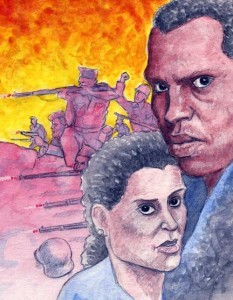On April 26, 1937, during the Spanish Civil War, the Nazis tested their new air force on the Basque town of Guernica in northern Spain. One-third of Guernica’s 5,000 inhabitants were killed or wounded.
Pablo Picasso exposed the horror of the bombing in his famous anti-war painting called Guernica.

Guernica painting by Pablo Picasso.
A reproduction of the painting hangs in the United Nations Security Council in New York. When U.S. leaders were announcing the war on Iraq, they shrouded the Guernica with a blue curtain rather than allow the realities of war be in full view. Learn more in the Democracy Now! broadcast “Amy Goodman in Spain on the 75th Anniversary of Guernica Bombing, Portrayed by Picasso Painting.”
Who came to the aid of the people of Spain? Read what Robin D. G. Kelley wrote in the introduction to The Lincoln Brigade: A Picture History:
 If we understand World War II as a global struggle against fascism, then the conflict begins in Spain in 1936 with General Franciso Franco’s army mutiny against the democratically elected Republican government. It is called a “Civil War,” but this is really a misnomer. Without support from Mussolini’s Italy, Hitler’s Germany, and Portugal under the dictatorship of Antonio de Oliveira Salazar, Franco and his rebel troops could not have succeeded. Military and material aid shifted the balance of power, and the Western democracies’ decision to stay neutral and impose an embargo on the Republic contributed to the unequal balance of power. . .
If we understand World War II as a global struggle against fascism, then the conflict begins in Spain in 1936 with General Franciso Franco’s army mutiny against the democratically elected Republican government. It is called a “Civil War,” but this is really a misnomer. Without support from Mussolini’s Italy, Hitler’s Germany, and Portugal under the dictatorship of Antonio de Oliveira Salazar, Franco and his rebel troops could not have succeeded. Military and material aid shifted the balance of power, and the Western democracies’ decision to stay neutral and impose an embargo on the Republic contributed to the unequal balance of power. . .
My students generally know nothing about the Spanish Civil War, but they follow my line of reasoning and some are persuaded. But when I tell them that nearly 3,000 Americans traveled to Spain to defend the Republican government from fascist forces, and that they were joined by another 35,000 volunteers from around the globe, that is when I lose them. Most stare at me in utter disbelief. . .
Every year I teach the story of the Spanish Civil War and the heroic participation of the International Brigades because it represents perhaps the greatest example of internationalism in the 20th century. They volunteered not only to defend one country but to defend humanity; they honestly believed that old labor slogan, “an injury to one is an injury to all.”
Their story ought to be common knowledge, but just try to find a high school student who has heard of the Spanish Civil War. We should not be too surprised by this sad state of affairs. The role Americans played in the fight for Spanish democracy was more than “forgotten”; it was consciously erased from our collective memory. Cold Warriors tried their best to turn a noble example of democratic liberalism into a vile act of subversion, and when that failed, history textbooks and social studies teachers simply ignored the Lincoln Brigade. Why? Because those who volunteered were labelled subversives — they were “premature antifascists.” . . . Continue reading.
Below are recommended classroom resources on the Spanish Civil War and the Abraham Lincoln Brigade.











Twitter
Google plus
LinkedIn